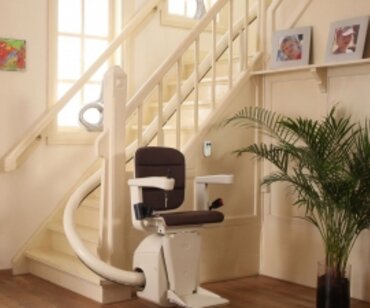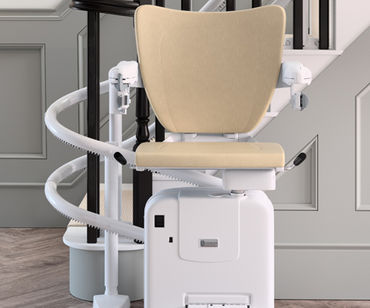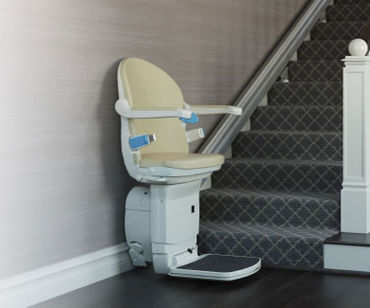Best stretching exercises for over 60s
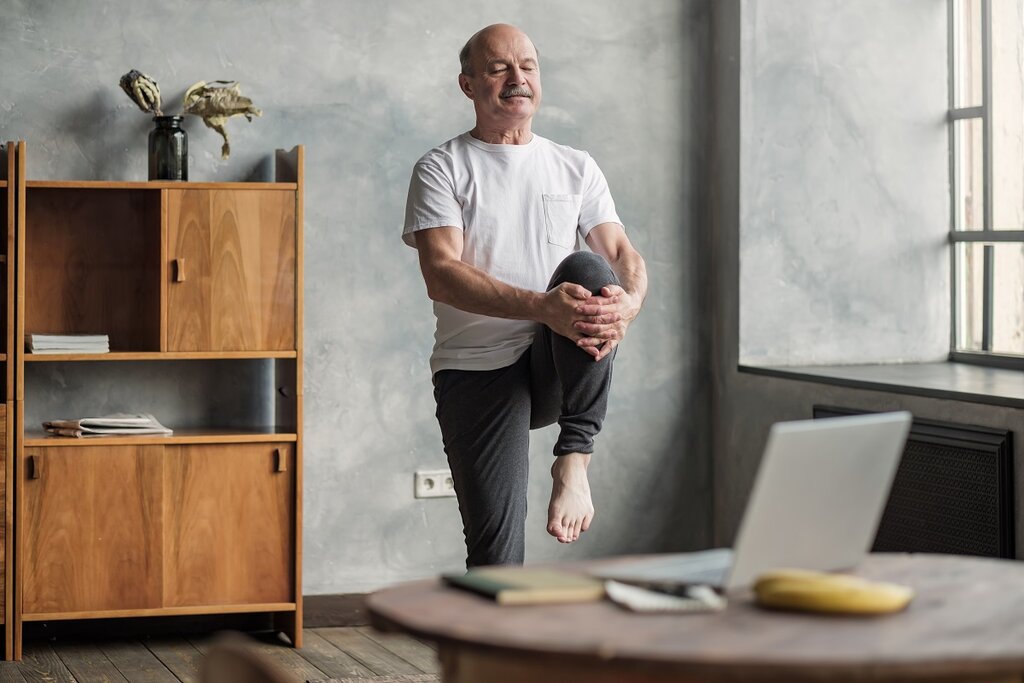
It’s no secret that as we get older, we become more at risk of chronic pain, stiff joints and weakening of the muscles. But how can older people maintain their physical health and help avoid future ailments? Stretching each day can be a great tool in your arsenal, and in this guide, we explain the importance of stretching for seniors and provide some examples of stretching exercises over 60s can try.
Why are daily stretches important for over 60s?
“As we get older, the risk of osteoarthritis looms large for many of us - over 30% of over 65s, in fact,” says Personal Trainer Russ Howe. “Stretching can help manage the pain caused by arthritis as it will improve the mobility and range of motion of our major muscle groups.”
For many of us who work in offices, Russ says stretching is important for correcting the damage from sitting at a desk all day. “After working with many clients in the gym who have careers in office-based work, stretching is wonderful for correcting posture.
“If we spend years sitting at a desk, our body begins to take that shape permanently, and we see our shoulders start to round, causing a hunched effect which we then carry around in our everyday life. But by stretching regularly, we can alleviate this issue and bring ourselves back into line.”
Deborah Stone, the co-founder of My Aging Parent, also suggests trying other stretch and flexibility-based exercises to improve posture and realign joints:
“Pilates acts as a bridge between physical fitness and physical therapy and can be adapted, modified and customised to meet individual needs. It is much more about the physical condition than age.
“Tai Chi involves proper bending and stretching of the joints. It improves posture so that your internal organs don’t get squashed up into odd positions, and you also learn how to breathe properly. You learn how to move with an awareness of where your weight is so that your joints are properly aligned.”
How often should stretches be carried out?
It is typically recommended that a person stretches for 20-30 minutes every day.
If this is too frequent for you, Lynne Cantwell, Consultant Physiotherapist at Six Physio, recommends stretching for 30-40 minutes for four to five times per week.
READ ALSO: Simple circulation exercises for Arthritis and how to include them in everyday life
What sort of results can you expect from stretching daily?
Daily stretches for over 60s can result in “greater mobility, suppleness and less pain,” says Deborah. Suppose you’re participating in something a little more intense such as Pilates. Deborah says the results can be much greater in that case, leading to improved ankle and foot mobility, fewer falls, and reduced chronic pain. These are big benefits for users of curved and straight stairlifts.
Lynne says stretching is a useful way to help maintain the range of motion and flexibility in muscles: “Daily movements ensure continued fluidity in joints and muscles and avoid stiffness which increases the risk of injury and pain.”
Antony Lo, a physiotherapist at The Physio Detective, believes that you can cut risks even more if you incorporate exercise into your lifestyle: “Just by achieving 150 minutes of exercise per week (including two 10-minute sessions of full-body strengthening), you can expect a significant decrease in bowel cancer, breast cancer, stroke, heart problems and diabetes amongst many other conditions. Strengthening exercises have been shown to increase bone mineral density, strength and balance.”
The best stretches for over 60s
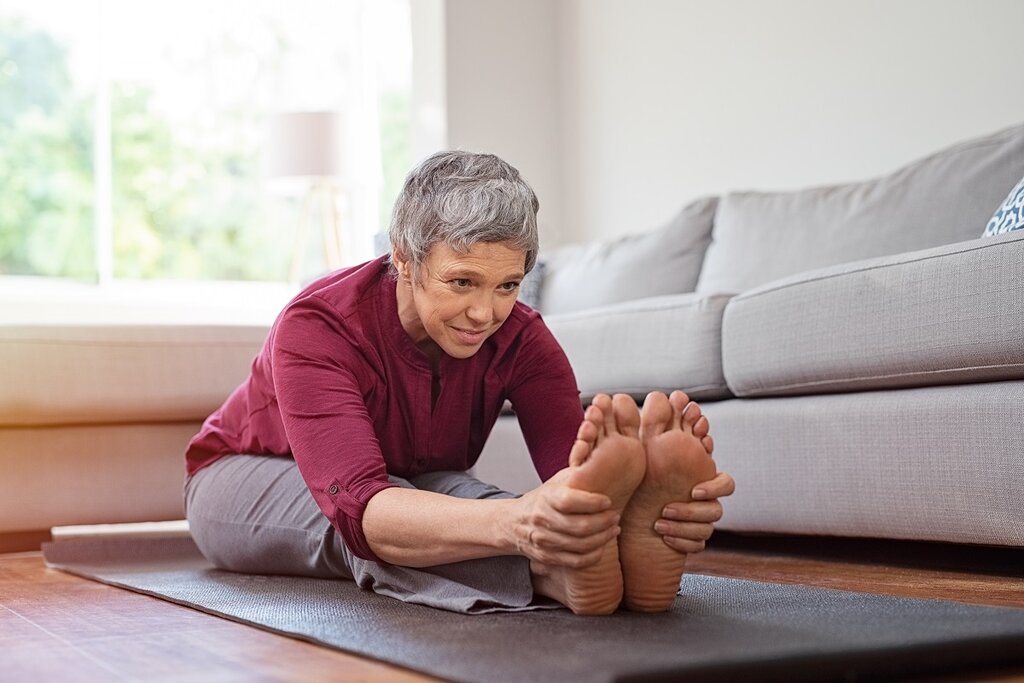
There are many stretches to add to your daily routine, but which are the best stretching exercises for over 60s?
As a personal trainer, Russ Howe works with individuals of all ages, abilities and backgrounds. His website is also chock-full of great workout and fitness tips for anyone looking to improve their health and fitness.
With his wealth of expertise and knowledge in working with older people, we asked Russ about some of the most common stretches he recommends to over 60s, getting him to take us through the advantages of each stretch and how it can be carried out at home.
Read on to discover some gentle stretching exercises to try.
Arms, shoulders, and chest stretching exercises for seniors
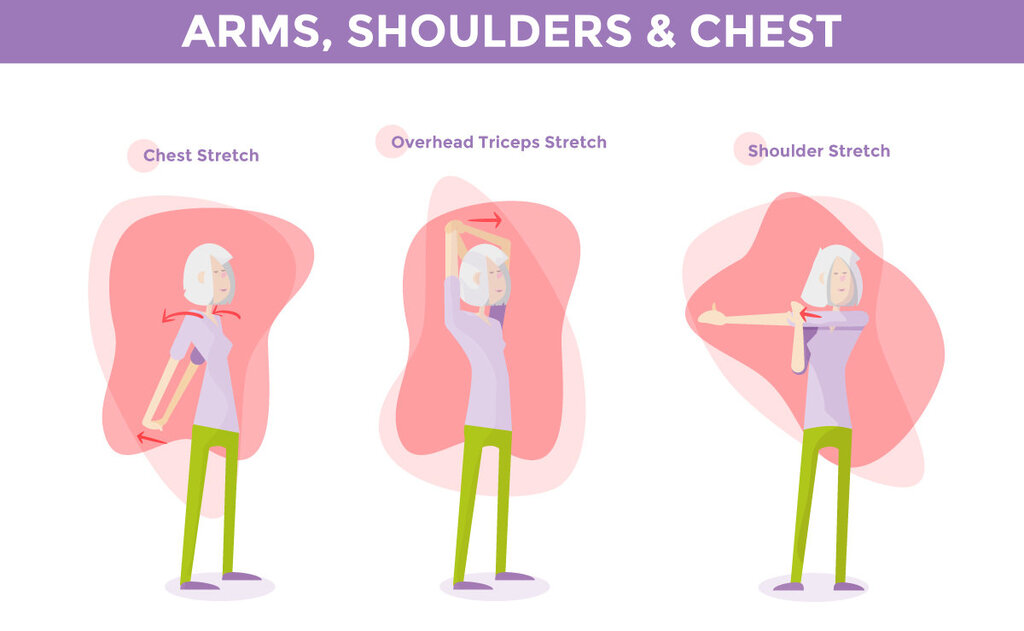
Chest stretch
Many of us have tight chest muscles due to spending too much time hunched over a desk, so this is a good move for gradually correcting the issue.
How to do it:
Place your hands behind your back and try to push your shoulders back while sticking your chest out. If you don't have the mobility to do this, you can place one hand behind a door frame and lean forward slightly, creating the same effect.
Overhead triceps stretch
You use your triceps every time you push something (or even just straighten your arm). For instance, the next time you're pushing the shopping around the store, your triceps are hard at work. So, it's important to keep them flexible and ensure they have a full range of motion.
How to do it:
Reach one arm overhead with your palm facing forward, then lower it to the base of your neck. Use your spare hand to push the elbow back slightly, creating a stretch in your triceps.
Shoulder stretch
If there's one body part that receives the most injuries, it's the shoulders. They do so much work on a daily basis; it is always a good idea to look after them. Having more flexible shoulders will help you when you reach for anything overhead or hold anything away from the body.
How to do it:
Take one arm across your body at shoulder level. Use your spare hand to hold the arm in position by pushing down either above or below (but not on) the elbow joint. Then work on the other side.
READ ALSO: Top tips for stairlift users to keep fit
Neck, back, and hip stretching exercises for seniors
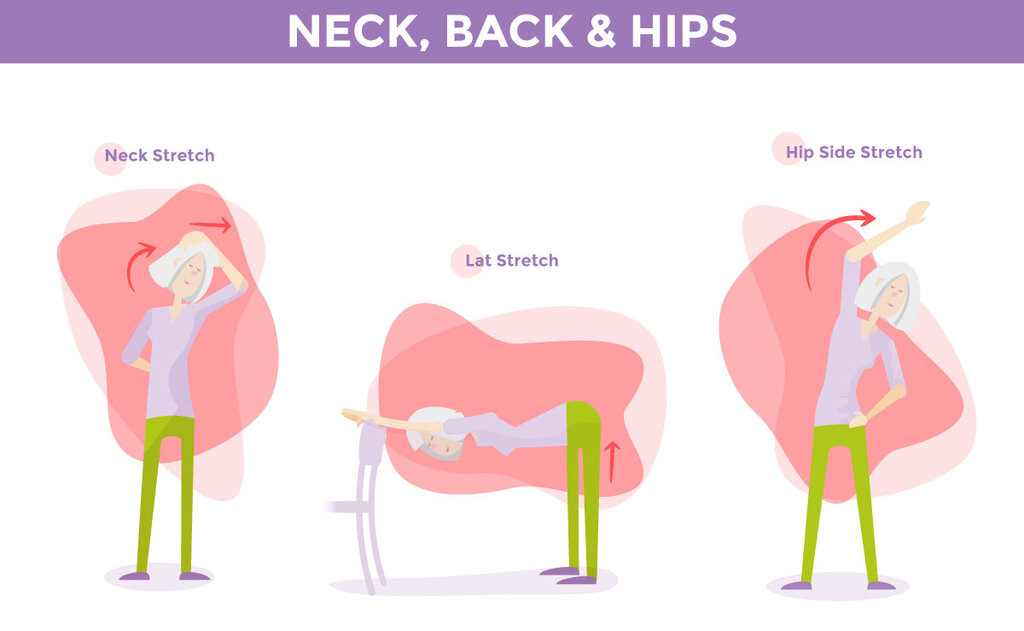
Neck stretch
A neck stretch is one of the best stretching exercises for over 60s. How often have you woken up with a tight neck after ‘sleeping funny’ and then spent the following day walking around like a robot? Making sure you have full mobility in your neck makes life easier.
How to do it:
Take your head through each of the following phases - look down, look left, look directly up, look right, tilt to the left, and tilt to the right. It's as simple as that.
Lat stretch
This is another great move for anyone who has worked in an office job for years, as it'll pull your posture back into shape in no time. Plus, most of us develop back issues as we grow older, so there is no harm in protecting ourselves with daily stretching. You'll notice the difference the next time you're in the garden!
How to do it:
Place your hands out in front of you (or on the back of a chair if needed), drop your head and try to push your shoulders forward. You'll feel a stretch across your upper back. If you can get up and down comfortably, you can try a more advanced version of this stretch, which requires you to begin from a kneeling position. Reach forward until your hands are at 10 o'clock and 2 o'clock. Sit back into the stretch until you feel the muscles on both sides of your back stretching.
Hip side stretch
If you're often out walking or jogging, chances are you have tight hip flexors. It's also particularly common in women, and tight hips can be prevalent in older adults, making this one of the best senior stretching exercises.
Here's a little test for you: If you lay on your back and the position which you find most comfortable is one which allows you to still push your hand under the small of your back (as opposed to your back being flat on the ground), then your hips are tilted forward and are probably in good need of a stretch.
How to do it:
From a standing position, place one hand on your hip and then take your other hand overhead, leaning slightly towards the side that has your hand on your hip.
Legs and ankles stretching exercises for seniors
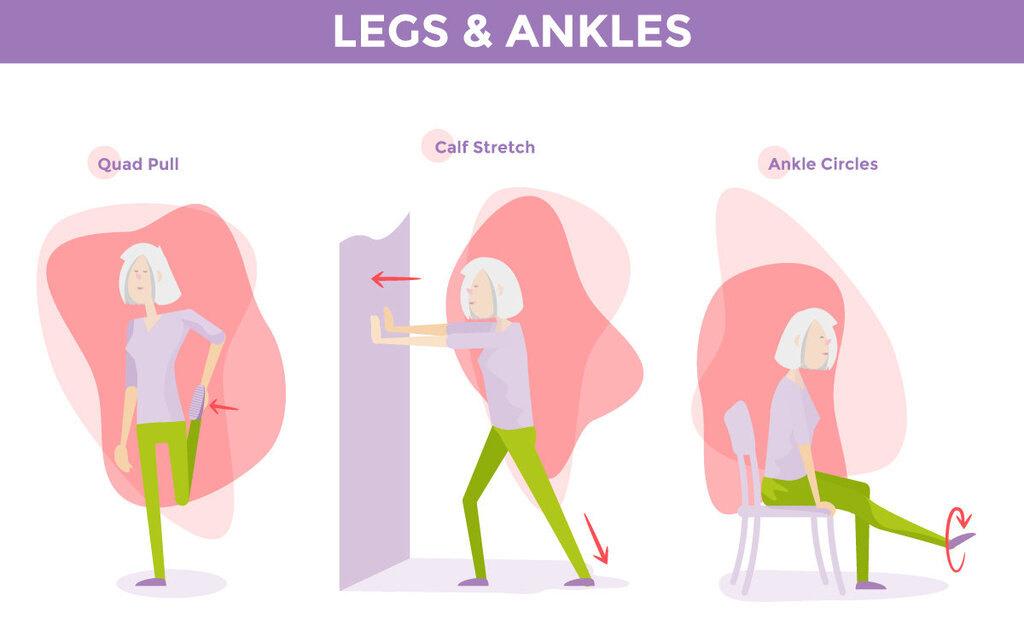
Quad pull
If you enjoy getting out on your bike, quad pulls will be your new best friend, making climbing the stairs easier too!
How to do it:
Stand with both knees together and grab something nearby for support if needed. Next, use your free hand to pull your shoe to your bottom and hold the position until you feel a stretch run down the front of your thigh. Then switch legs. You can also perform this while lying on one side.
Calf stretches
Another one for the walkers. Our calves work all day to support us when we are on our feet, no matter whether we are decorating the house or hosting a family get-together. But it's a muscle most people neglect to stretch.
How to do it:
Stand with your hands against a wall and create a 45-degree angle with one foot remaining forward for balance. Drive your heel into the ground, and you'll feel a great stretch in your calf muscle.
Ankle stretches
How well you can get low down to the ground largely depends upon your ankle mobility. If you can improve ankle mobility, you will notice how much easier it is to bend down in the garden or reach for items from awkward bottom cupboards in the kitchen. As a result, this is among the most helpful stretches for over 60s.
How to do it:
Sit on a chair and lift your ankle a couple of inches off the floor. Point your toes and gently rotate your ankle as if you were drawing big circles. Repeat with the other foot.
For an added ankle stretch, hold something for support, and then instead of getting up onto your tiptoes, stay on your heels and try to lift your toes off the ground. This can also be done by sitting on the ground with your legs out in front, placing a towel around your toes (if you can’t reach them), and pulling gently.
READ ALSO: Why over 60s should join a virtual fitness class
Morning stretches for over 60s
Our bodies can often be at their most stiff first thing in the morning. So, to help you start the day off on the right foot, we have listed below some gentle stretching exercises over 60s can try in the mornings.
- Neck stretch: Slowly tilt your head to the right and left five times on each side.
- Shoulder stretch: Lift shoulders up to your ears and then slowly lower them back down five times.
- Arm stretch: Lift your right arm over your head and hold your left elbow. Gently pull your left arm towards your right shoulder and hold for 10 seconds. Repeat on the other side.
- Backstretch: Stand up straight with your arms extended overhead. Slowly bend backwards and reach for your toes. Hold for 10 seconds and then return to standing.
- Hip stretch: Stand with your feet shoulder-width apart and bend your right leg. Reach your right arm towards your left foot and hold for 10 seconds. Repeat on the other side.
- Knee to chest stretch: Sit on the floor with your legs extended in front of you. Bend your right knee and bring your foot towards your chest. Hold for 10 seconds, and then repeat on the other side.
- Calf stretch: Stand facing a wall with your feet shoulder-width apart. Lean forward and place your hands on the wall at shoulder height. Keep your back straight and your heels on the ground. Hold for 10 seconds.
- Quadriceps stretch: Stand up straight and hold your right foot behind you with your right hand. Gently pull your heel towards your buttock and hold for 10 seconds. Repeat on the other side.
- Hamstring stretch: Sit on the floor with your legs extended in front of you. Bend forward and reach for your toes, holding the position for 10 seconds.
From correcting posture to improving daily mobility, stretches can benefit various individuals, regardless of age or ailments. For more information on daily stretches and exercises for older people, look at the NHS’s physical activity guidelines for older adults.
Whether you lead an active lifestyle or you use UK stairlifts and other mobility aids, stretches can benefit everyone, and they can always be adapted to fit your needs with the help of a certified personal trainer or physiotherapist.
Click to download and print the above daily stretches
For more tips, guides, and advice, visit our news page.

